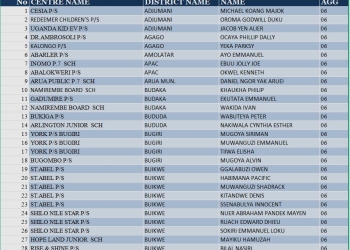
KAMPALA, Uganda — Uganda’s private sector experienced further expansion in operating conditions during April, driven by increased activity and a rise in new orders, according to the latest Stanbic Purchasing Managers’ Index (PMI) released Monday.
The headline Stanbic PMI climbed to 55.3 in April, up from 52.9 in March. A reading above 50.0 indicates an improvement in business conditions compared to the previous month.
The survey highlighted that the overall upturn was fueled by expansions in both activity and new orders, with respondents reporting a strong sales environment. Business output expectations for the coming year remained positive, leading firms to increase hiring and expand input buying to meet the growing demand. The rise in employment helped to further reduce backlogs.
Christopher Legilisho, Economist at Stanbic Bank, noted the strength of the April PMI data, suggesting a “vibrant private sector” with increasing optimism about current and future consumer demand.
“Private sector business conditions expanded for a third consecutive month due to strong, sustained customer demand resulting from further marketing campaigns driving both new orders and output,” Legilisho said. He added that the output increase was broad-based across sectors, with firms gaining new clients and consumer purchasing power improving. To meet this strong demand, companies increased employment, purchasing activity, and inventories, leading to a decline in backlogs.
The Stanbic PMI, compiled by S&P Global, is based on responses from approximately 400 purchasing managers across sectors including agriculture, mining, manufacturing, construction, wholesale, retail, and services. It is a weighted average of five indices: new orders, output, employment, suppliers’ delivery times, and stocks of purchases.
The survey also revealed that greater purchase and staff costs led to an increase in overall input prices during April. Consequently, companies sought to pass on these higher costs to consumers, resulting in a further rise in output charges.
“However, input and output prices increased due to elevated utilities bills as well as higher purchase costs due to price hikes for a selection of items. Staffing costs increased too because of more employees to cater for the workload,” Legilisho explained.
April marked the third consecutive month of expansion in new business for Ugandan firms, attributed by panelists to successful marketing campaigns that attracted new clients and boosted sales. Growth in activity and new business was observed across various sectors.
In line with increased output levels, Ugandan businesses continued to create jobs for the third straight month in April. This additional hiring supported output requirements, contributing to a fourth consecutive monthly decrease in backlogs of work.
Buoyed by rising new orders, companies also expanded their purchasing activity. The latest increase in input buying was partly driven by efforts to build safety stocks, with inventories accumulating for the second consecutive month.
However, pressure on supplier capacity re-emerged in April, with delivery times lengthening for the first time in 17 months.
Simultaneously, higher purchase and staff costs contributed to another increase in total input prices at the start of the second quarter. Panelists cited higher utility and material costs, along with increased wage bills, as the primary drivers.
Despite rising input costs, firms were largely successful in passing these costs on to customers, as output charges continued to increase. Looking ahead, many business owners expressed confidence in further activity growth over the next year, citing expectations of stronger client demand and planned investments in advertising.

















